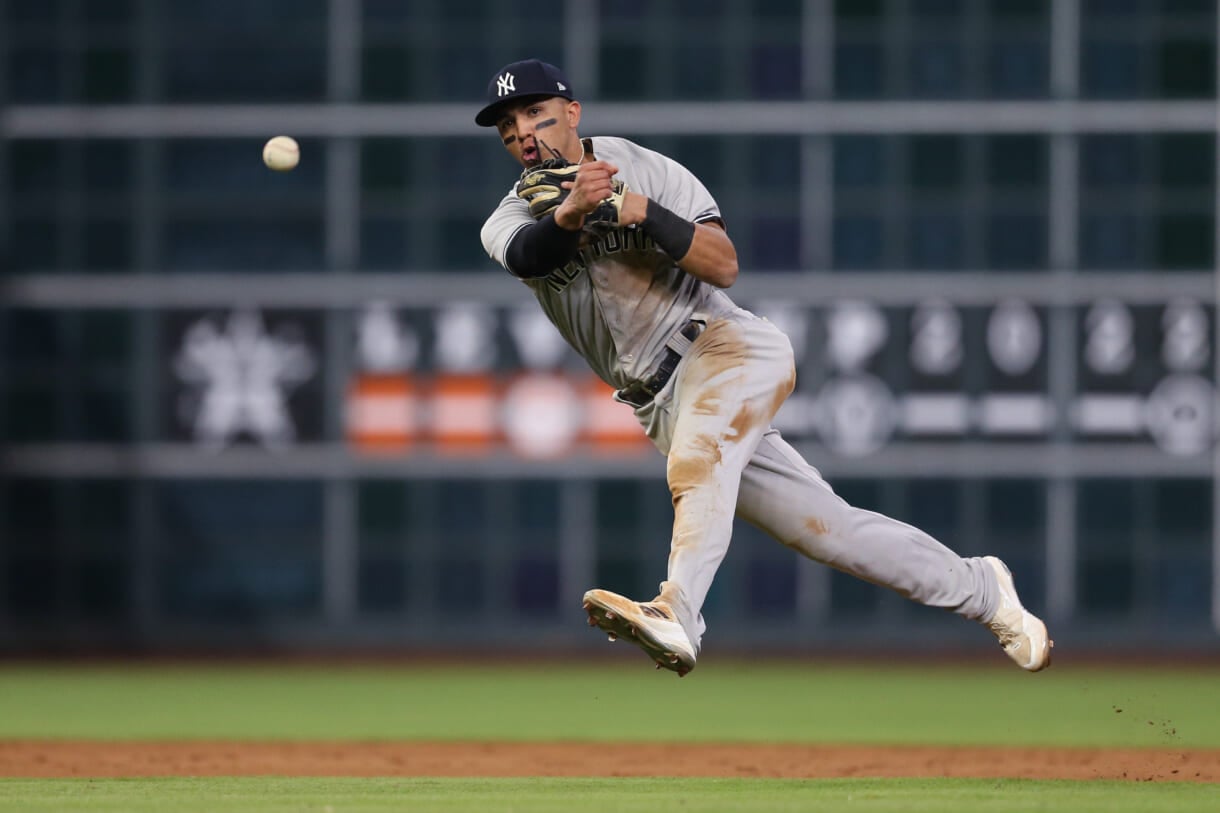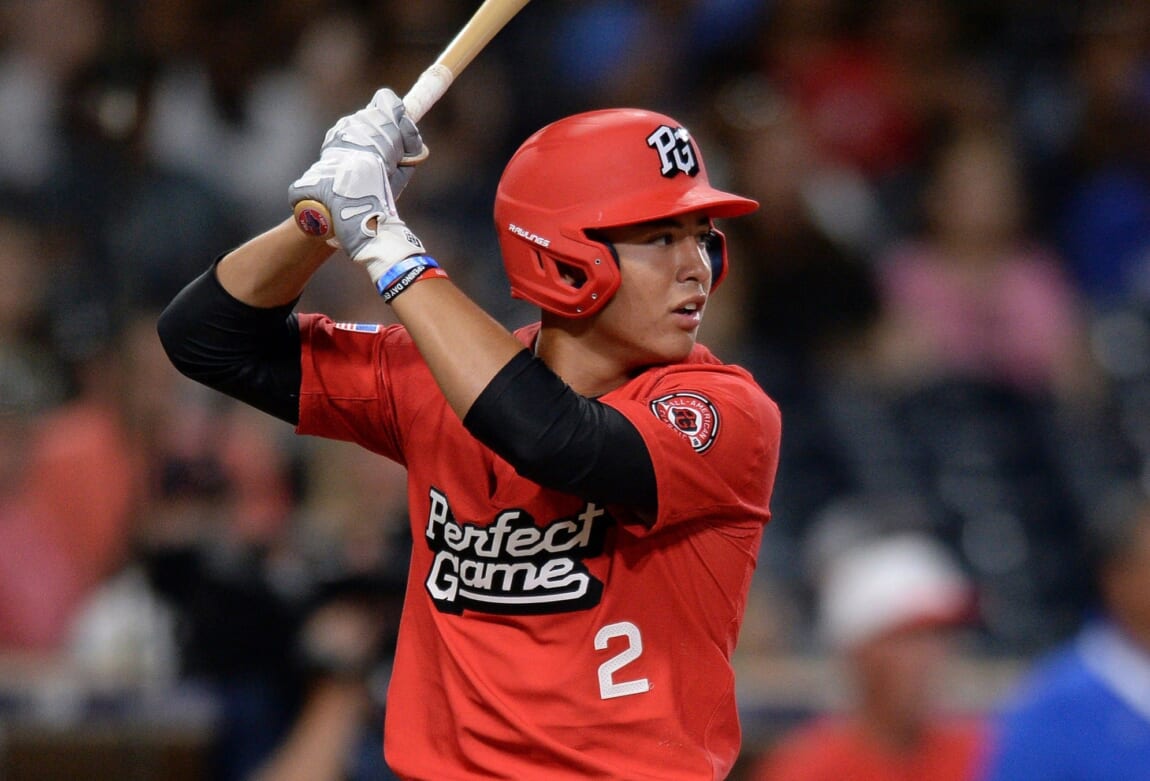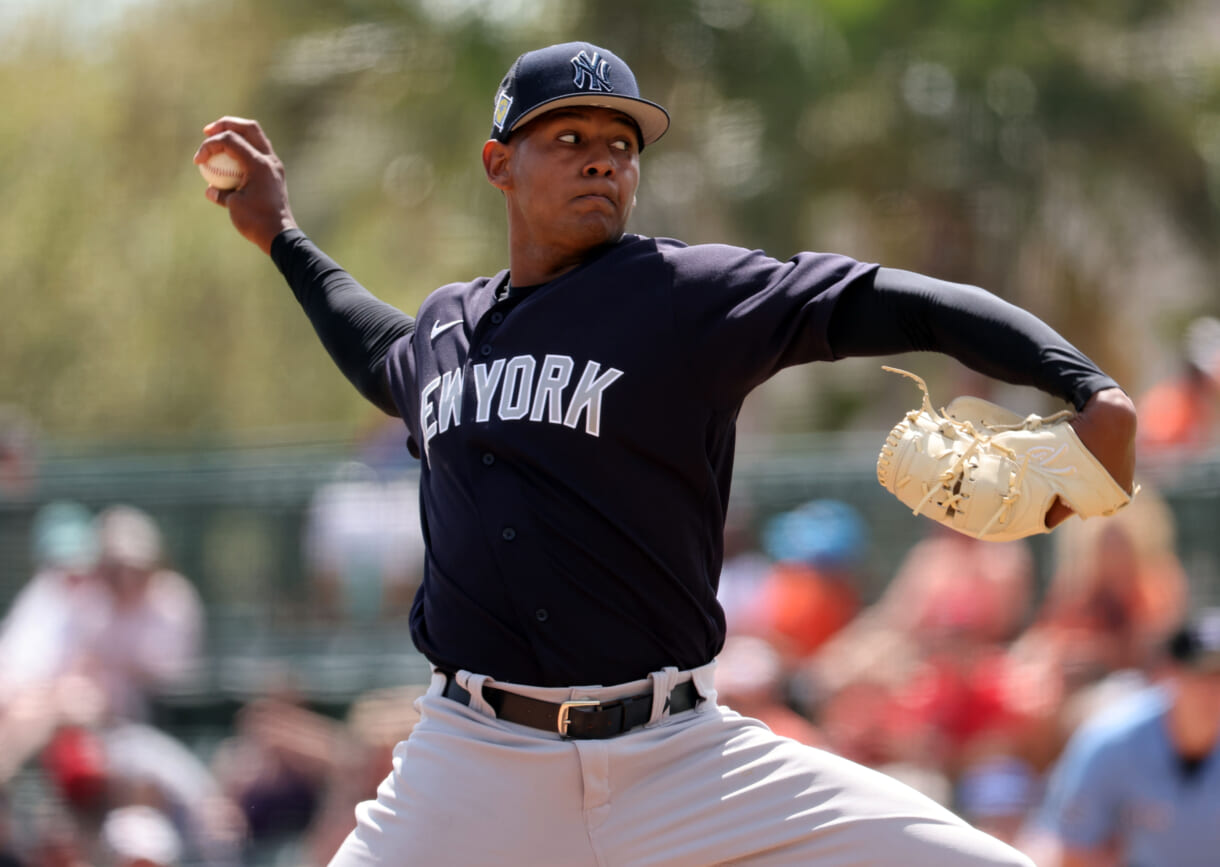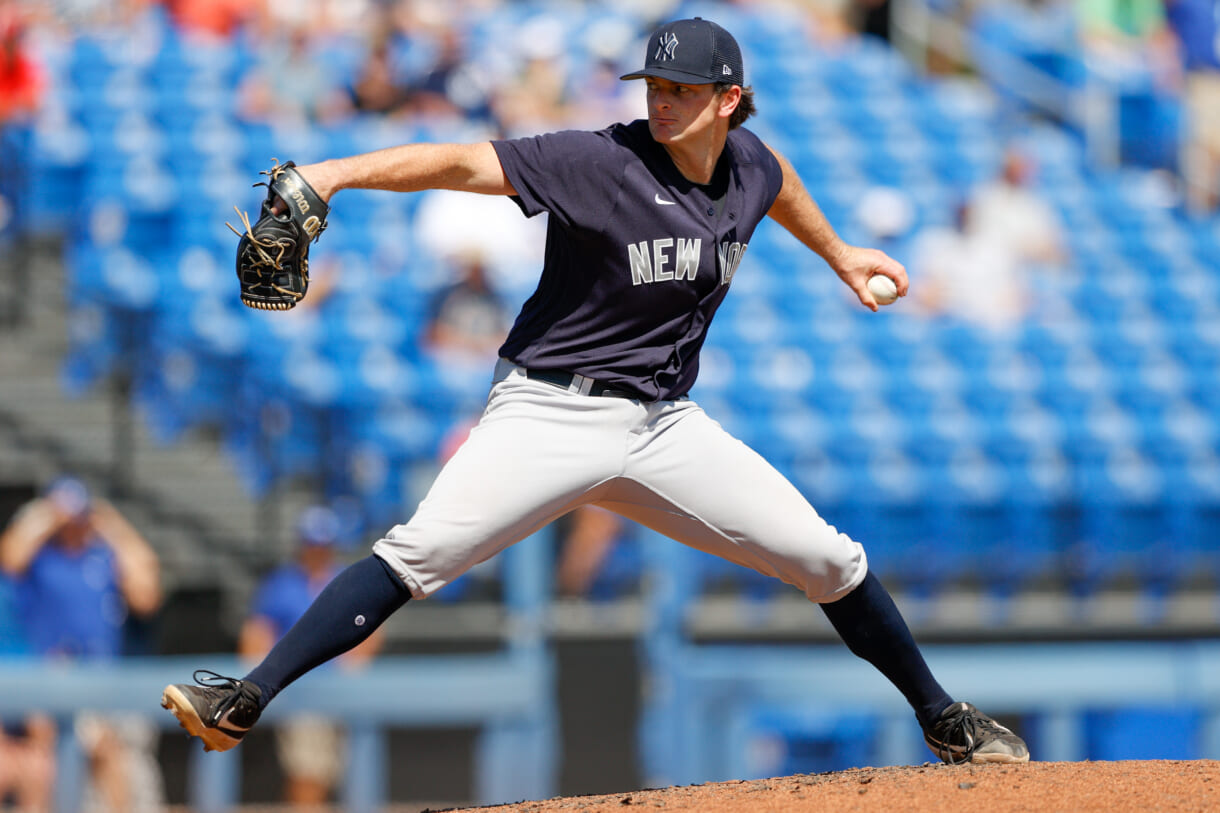
The Yankees play their first Spring Training game on February 25th, meaning we’re less than a month away from Yankees baseball. It’s not the same as the regular season, but there’s plenty of data and information to extract from Spring Training. With the help of Statcast, we can track important information that’ll go a long way toward finding breakout candidates for 2023. There are positional battles that’ll be settled in the Spring, with massive implications for the future of the franchise and the direction of 2023. The journey to winning a World Series is a long one, but here are some of the faces who hope to play a role in getting them to the promised land.
- Yankees activate exciting outfield prospect off of IL, remains in Triple-A
- Yankees are ‘actively’ targeting help at 3B at the trade deadline
- The Yankees need to make a big push for this perfect infield trade target
It’s a Rookie’s World at Shortstop
Entering camp, the favorite to win the shortstop job is standout rookie Oswald Peraza, who came up last season and showed his excellence at the plate in a limited sample size. With a 146 wRC+ highlighted by a .404 OBP, he showed that his bat can really come alive when he’s fully comfortable. He shook off some rust at Triple-A earlier in the season, as he had a wRC+ of just 64 at the end of May. From June onward, his offensive skills improved across the board:
- Final 79 Games (AAA/MLB)
- 324
- .294/.372/.497
- 134 wRC+
- 15 HRs
- 22.5% K%
- 9.0% BB%
There are clear signs of improving plate discipline and an advanced feel for pull-side power that allows him to hit plenty of HRs. If we get an Oswald Peraza who can hit ~.260, we could see him post an OBP near .330 and SLG of .400-.420, which would get him close to league-average offense. We know about his excellence as a defender, with a strong arm and great instincts that should allow him to not just be an MLB-caliber shortstop but a gold-glove candidate. When we evaluate his game, there are plenty of obvious factors that are going to aid him in this battle for a starting job on the Yankees.

The biggest thing going in Peraza’s favor here is that he’s the middle-ground between inexperienced with upside and clearly MLB-ready on Opening Day. Anthony Volpe struggled in a small sample size at Triple-A, which won’t have a major bearing on his long-term outlook but will definitely have an impact on whether he makes the team on Opening Day or not. Isiah Kiner-Falefa is the most experienced option at the position, but the massive issue is a limited ceiling and being a worse talent than Oswald Peraza is currently. End of the day, the Yankees would rather have an average contact tool with plus power over a great contact tool with little to no power.
We can argue about the role contact needs to play on the Yankees in 2023, but it’s more important to lead the league in SLG% than it is to lead the league in contact rates. That isn’t to say you shouldn’t be concerned if an offense has clear deficiencies in the strikeout department, but Peraza isn’t going to hamper you in that regard. There’s also plenty of baserunning upside with 90th Percentile Sprint Speeds and great stolen base numbers in Triple-A. He’s the frontrunner for this job, but is there an argument for Anthony Volpe?
Anthony Volpe is compared to Derek Jeter with his off-the-field demeanor and leadership qualities, but how does he stack up in this shortstop battle? Well, he’s clearly got the most upside in his field, and this isn’t just something you say about the Yankees’ #1 prospect, but something backed by projections as well. When we evaluate the three competitors for the shortstop job, it’s clear that Volpe is the best player in the group. Using ZiPS, we can look at percentile outcomes for a player’s 20th and 80th percentile alongside their median outcome (50th percentile). Let’s first look at their expected outcomes:
| Metric | Anthony Volpe | Oswald Peraza | Isiah Kiner-Falefa |
| WAR | 3.1 | 2.1 | 0.2 |
| OPS+ | 100 | 90 | 78 |
| DEF | +1 | +3 | -9 |
We see here that ZiPS is pretty conservative with projecting rookies, and rightfully so. The clear issue they have with IKF here is his defense, viewing him as an awful defensive option at the SS position, which I definitely think is harsh. Peraza’s the best projected defensive option of the three, but I believe they’re underselling his defensive value relative to Volpe. He’s a solid defensive shortstop, there’s no better way to put it. For their offense, Volpe is viewed as by far the best bat of the three, and for good reason as well. When we evaluate their 80th-percentile outcomes, we see very quickly why Anthony Volpe is so hyped up.
| Metric | Anthony Volpe | Oswald Peraza | Isiah Kiner-Falefa |
| WAR | 4.4 | 3.3 | 1.3 |
| OPS+ | 120 | 108 | 94 |
This is where it becomes very clear that IKF’s time on the Yankees should come to an end before April. Defensively we don’t have the same percentile outcomes, but even if we assume great defensive play, why not go with Peraza, who could be a +10 defender and give you a 108 OPS+ at his 80th percentile? That would be a 4-5 WAR player, something we just don’t see as a plausible outcome with the former Texas Ranger. Lastly, looking at the 20th percentile should give us a good idea of what these players would look like if things don’t go according to plan.
| Metric | Anthony Volpe | Oswald Peraza | Isiah Kiner-Falefa |
| WAR | 1.6 | 1.0 | -1.2 |
| OPS+ | 81 | 72 | 59 |
What we’re looking at here is a doomsday outcome for the Yankees, but even then, Volpe and Peraza are slightly below-average players as a whole. IKF is in DFA territory in this scenario, again cementing the idea that there really isn’t much reason to consider him a serious candidate. Volpe definitely is the best player in this group, but his inexperience creates a wide distribution of results that could cause the Yankees to want to be patient. If he doesn’t pan out, people in the organization get fired, it’s that simple.

He can certainly prove himself just like Julio Rodrguez did the year before, but it’ll be an uphill battle against Oswald Peraza in camp. Unless they trade Gleyber Torres, Volpe’s alternative to making the team is spending time in Triple-A, where he’ll be patiently waiting for a chance to become an everyday regular on the Yankees. He’s got the speed, bat, and glove to go out there and force his way onto the roster, but the Yankees need to make the right decision for his long-term development as well.
It’ll be an interesting battle to follow, but I don’t believe it’s as odd as the battle for left field could end up becoming.
A Platoon Candidate in Left Field
Aaron Hicks and Oswaldo Cabrera seem like the only two candidates to fight for a starting job in left field, but they could still sign a bat. The other variables here are the various outfielders who received MiLB contracts, most notably Rafael Ortega, formerly of the Chicago Cubs. Last season, Ortega posted a 96 wRC+ and 0.7 fWAR in 118 games last season, which underwhelmed enough to get him non-tendered by the Cubs and enter free agency. The Yankees could help unlock an extra level to Ortega’s game, as he’s a left-handed bat with plenty of loft in his swing.
Ortega’s a low-whiff bat with plenty of patience, ranking in the 82nd Percentile in Whiff Rate and 70th Percentile in Chase Rate. His raw power isn’t great, but with an approach that generates plenty of line drives and flyballs with a 42% Pull%, there’s a potential for plenty of longballs in 2023. When we look at his spray chart overlayed with Yankee Stadium, you can let your imagination run wild with what Ortega could potentially provide off the bench for the Yankees.

Ortega had just a 98 wRC+ against RHP last season, but in 2021 we saw a 141 wRC+ and 11 HRs in just 246 At-Bats, giving us a floor and ceiling to evaluate here. If Ortega can get you a 105-110 wRC+ against RHP specifically, this opens up the opportunity for the Yankees to platoon in the outfield. Aaron Hicks has consistently hit LHP better than RHP, posting higher exit velocity totals and quality of contact metrics. Since 2021, the splits are dramatic:
- vs RHP
- .298 xwOBA
- 86.3 EV
- .319 xSLG
- vs LHP
- .340 xwOBA
- 91.6 EV
- .444 xSLG
Having a platoon of Ortega and Hicks initially sounds nauseating, but when we delve into the numbers, we see that Hicks puts up good batted ball numbers and solid production against LHP, while Ortega can give you similar production against RHP. Hicks is still an excellent defensive LF with good baserunning skills, with 8 DRS and 1 OAA in just 413 innings out there. His BsR last year was +2.5, stealing 10 bases at a ~77% success rate. With bigger bases, perhaps he’s more aggressive on the basepaths as well, and the Yankees could platoon their way to passable production in LF until a potential upgrade becomes available at the deadline.
If you see Ortega attempting to pull more than ever to utilize the short porch in the Bronx more, it’s a sign of what he could be in the regular season. It’s not a flashy move, but platooning could be the Yankees’ best course of action here. Keeping Oswaldo Cabrera as their utilityman in 2023 is vital as if anyone goes down with injury or mightily struggles, he can provide a presence as a solid switch-hitter with serious upside if his improvements at the plate are sustained. Ortega’s worth watching in Spring Training, and if you see him consistently playing with the starters in the lineup, it’ll be a sign of a potential platoon in LF.
Starters With Plenty to Prove
The Yankees have some seriously nasty arms in their farm system that can take a leap forward in 2023 and become mainstays in their pitching staff either this year or next. With Frankie Montas out for at least the first month of the season, there’s serious competition for that 5th starter role, with Domingo German and Clarke Schmidt leading the way. That being said, there are some darkhorse candidates that could compete for that 5th starter job or for a spot in their bullpen.
Randy Vasquez has elite stuff that could get even better as he becomes more comfortable with larger workloads. He had a career-high 115.1 innings pitched last season, making 25 starts for the Somerset Patriots and having a 3.90 ERA and 3.90 FIP. He showed flashes of excellence but struggled with consistency. The information on Vasquez’s stuff is superb, as his slider is an elite pitch that he’s made his go-to strikeout pitch. When we look at the three main pitches he uses it’s his fastball, curveball, and changeup, and running it through a Stuff Grader, we see some promising data:
- FF: 48
- CU: 67
- CH: 57
These would round up or down in Cameron Grove’s PitchingBot model to a 50, 65, and 60, giving Vasquez a solid fastball with great secondaries. His east-west movement makes him a nightmare for batters to face, with 32.4″ of horizontal separation between the fastball and curveball, with his curveball serving more as a slider/curveball hybrid due to its sweep and drop.
He had a 15.9% K-BB% and 48.3% GB% in Double-A last season, but if he can be more consistent and share his command close to the group of arms that can generate a K-BB%? 16% and GB%? 50%. Only five pitchers reached both of those marks in 2022, and it’s safe to say these guys were pretty good.
- Sandy Alcantara (5.7 fWAR)
- Max Fried (5.0 fWAR)
- Alex Cobb (3.7 fWAR)
- Shane McClanahan (3.5 fWAR)
- Kyle Wright (2.9 fWAR)
We could see Randy Vasquez fight for a spot on the roster, but he’s got one thing working against him. He hasn’t tossed a single inning at Triple-A, making him the least experienced option of the group that’ll compete for a spot in the bullpen or rotation, and the Yankees have enough talented arms at the higher levels of MiLB or with MLB experience that would reasonably be higher on the depth chart. Even with that in mind, hopefully, we’ll get an extended look at Vasquez and see how he’s improved over the offseason, especially since he added a cutter with the Somerset Patriots to better handle lefties.

Looking at the under-the-radar prospects in the Yankees’ farm system, we see that Jhony Brito is someone that gets left out of plenty of pitching discussions. His strikeouts are underwhelming, but when we evaluate his pitch mix, we quickly see that there’s more than meets the eye with the Dominican-born starter.
Brito has plus velocity as a starter, averaging ~95 MPH on his fastballs, something that initially shocked me when I discovered it. It’s atypical for higher velocity arms with success at the Minor League level to get overlooked, so I believed it could’ve been an issue with pitch movement.
- FF: 50
- SI: 55
- CU: 40
- CH: 55
- CT: 55
- SL: 40
His breaking balls are subpar for sure, but we see that he has three solid fastball offerings and a good changeup to boot as well. His Stuff is definitely not good enough to be his best attribute, but with plus command and no issues with durability, it’s not a stretch to say he could come into camp with a realistic shot at becoming the 5th starter. With a 3.31 ERA and 54.4% GB% at Triple-A across 15 starts and 3 relief appearances, the next step Brito needs to take is getting his K-BB% back to the 15-16% range it sat at in 2022.
He spent some time in the Dominican Winter League, where he tossed 7.2 innings with a 3.52 ERA, 10 strikeouts, and 0 walks allowed. If he can refine either his curveball or slider to promote more swings and misses alongside his contact-managing abilities, we could be looking at a solid backend rotation arm. ZiPS projects him for a 4.20 ERA in 105.0 IP, which translates to a 98 ERA+ (2% worse than average), but the key here is the projected .286 BABIP allowed. Projection systems have caught onto Brito’s ability to suppress BABIP, and if he has plus command on 5-6 different pitches, he’ll overperform expectations.
The third Domincan-born arm on the list, Deivi Garcia, has plenty to prove in Spring Training. He added a cutter to the mix in 2023, but the big addition was a new curveball that he’s still working on commanding. When we last saw Deivi Garcia with the Big League team, it was back in Spring Training last March, where his curveball had just 5″ of horizontal sweep, however after spending time in Double-A and then getting recalled to Triple-A, he had a curveball with far more sweep and upside. Stuff Grades back this up, as we see it’s an average pitch that quickly becomes an elite one.
- Spring Training Curveball: 50
- New Curveball: 70
What caused such a dramatic difference in stuff? Well, it still generates -8.3″ of induced vertical break, creating over 25″ of vertical separation and ~15 MPH of velocity separation off of his four-seam fastball. The big difference is the nearly 18″ of horizontal sweep, creating a buzzsaw of a curveball that should help him get more strikeouts, but not unless he figures out the command of the pitch. His slider performed extremely well on its own, generating a 46.2% Whiff% and 34.2% Chase% as well. With just a .230 xwOBA allowed on the pitch, it’s clear that his slider is his best offering.
The problems with Deivi are when he faces LHBs, with RHBs having a .268 xwOBA and 35.2% CSW% against the young righty. Lefties, on the other hand, pummel Garcia’s stuff to the tune of a .420 xwOBA, chasing at under 20% of pitches thrown out of the zone. He added a cutter in 2022 that didn’t fare well (.348 xwOBA), but as he uses it more could be a nice weapon versus left-handed batters, as soft contact is something Deivi has to be able to generate more in order to avoid being DFA’d or outrighted off of the 40-Man Roster.
The main thing this cutter should do is help Deivi Garcia get more swings. Pitchers with larger movement profiles can have issues consistently getting batters to swing, but the answer here isn’t worsening what he does well with his sweeper or his four-seam fastball, rather, it should be to find the bridge in movement profiles. The cutter is supposed to bridge the gaps in horizontal movement created by his slider and fastball, and it’s supposed to help Deivi Garcia just get more batters to swing.
Oftentimes command issues are misdiagnosed as not being able to find the zone and not as an inability to get batters to swing. Perhaps the introduction of this cutter is the final piece of the puzzle for Deivi Garcia, but that’s something that we’ll have to see in 2023.
Relievers Looking To Breakout
Entering 2020, Jimmy Cordero looked to be a part of an up-and-coming White Sox team that would eventually make the postseason. He was coming off of a season where he tossed 37.1 innings at a 2.89 ERA and 59.4% GB% in 2019, but 2020 took a turn for the worst. After a hot start where he pitched to a 3.75 ERA and 2.77 FIP in his first 12 IP, Cordero had a 7.98 ERA over his final 14.2 IP, needing TJS after the White Sox Wild Card exit. He’s spent time rehabbing with the Yankees, where last season, we finally saw him in action at the Triple-A level with the Scranton Railriders.
He tossed 38.2 innings with a 2.09 ERA, generating a GB% of 51.7% and a K-BB% of 23.6%. That being said, the results are just a sign of progress, what truly entices me about Jimmy Cordero is his pitch mix. He used to throw 6 different pitches, mixing in a four-seamer, sinker, cutter, slider, curveball, and changeup. The issue with a diverse pitch mix for a reliever is that it means they throw their best pitch less frequently, and Cordero was a prime example of this. He used just a sinker and slider in 2022, adding sweep to his slider and showing he still has explosive velocity.
Averaging 96 MPH and over 16″ of run on his sinker to go alongside a slider in the mid to high 80s, he’s still an imposing figure on the mound who can jam a right-handed hitter and then get them fishing on a down-and-away slider. That doesn’t mean he didn’t handle LHBs either, holding them to a .270 xwOBA. The streamlined pitch mix was a success, and with a fully healthy offseason, he has a shot to make the Major League roster since he’s already on the 40-Man Roster.
Steamer, ZiPS, and ATC all project Cordero for an ERA under 4, and there’s a real chance last year’s progress is sustainable in 2023.

Matt Krook is a sneaky candidate to make the bullpen due to his sweeping slider and left-handed suppression. The Yankees only have Wandy Peralta as a left-handed option out of the bullpen, creating more interest in Krook in the Spring. He wasn’t great at Triple-A in 2022 with a 4.09 ERA and 13.6% K-BB%, but he worked on a cutter that could hopefully help him get more whiffs and bridge the sinker and slider. In terms of raw stuff, his pitches are pretty filthy.
- SI: 60
- SL: 70
- CT: 70
Simply put, Matt Krook is absolutely gross. I think we’re looking at someone who can not just impress in March but could also force his way onto the roster due to his high-octane stuff and the Yankees’ need for LHP. He has a funky delivery with a sweeping slider that’ll fit perfectly in the Yankees’ bullpen. Projections vary on his effectiveness, with Steamer, THE BAT, and ATC all having Krook as a sub-4 ERA arm, but ZiPS has him at a 4.49 ERA. The difference seems to be that ZiPS is mostly projecting his performance as an SP, where he’d most definitely struggle due to command and chase rate issues.
Out of every pitcher on this list, buy the most stock on Matt Krook. Considering all the variables that go into projecting who’ll make the final 26-man cut or not, Krook has everything working for him. Spring Training can’t come any quicker, and the Yankees have a lot in store for the fans to watch in a few weeks.